Physical Address
304 North Cardinal St.
Dorchester Center, MA 02124
Stromal and sex cord–stromal tumors of the ovary constitute a diverse collection that is derived from the ovarian cortical stromal and hilar cells ( Fig. 27.1 ). These cells form during embryogenesis as condensations of subcoelomic mesenchyme, in the form of “sex cords,” which ultimately differentiate into the supporting stroma of the cortex and the granulosa-theca cells of the developing follicle in the adult ovary. The same progenitor cells diverge to form the Sertoli and Leydig cells of the testis, and a subset closely resembling Leydig cells form the hilar cells of the ovary. The range of embryonic and adult differentiation seen in these stromal and supporting cells explains the complexity of tumor phenotypes attributed to them ( Fig. 27.2 ).
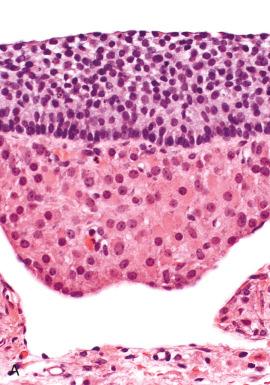
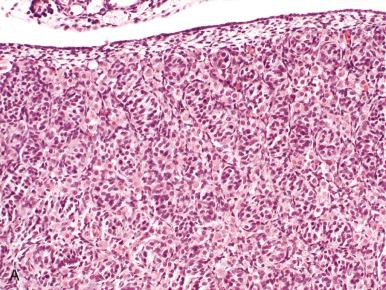
As a group, with the exception of highly malignant small cell carcinomas of the ovary that are of uncertain histogenesis, stromal and sex cord–stromal tumors are either benign (fibromas, thecomas) or low-grade malignancies (granulosa, Sertoli-Leydig cell tumors [SLCTs], steroid cell tumors). Diagnostic problems attributed to them are principally due to their rarity. Stromal and sex cord–stromal tumors constitute less than 10% of all ovarian tumors, and of these, nearly 90% are fibromas/thecomas, which are easily recognized. This leaves a small group that accounts for no more than 1% of ovarian tumors but that have a wide range of morphologic appearances. More than half of these are granulosa cell tumors. Hence, most patients dying of a sex cord–stromal tumor will succumb to a granulosa cell tumor.
This chapter organizes these tumors into groups that the pathologist can readily recognize and provides diagnostic alternatives to minimize the chance of misclassification.
Table 27.1 outlines the clinical features associated with the more common sex cord–stromal tumors of the ovary. They include the following.
| Type | Frequency a | Mean Age (Range) | Presenting Symptoms | Bilateral (%) | Other |
|---|---|---|---|---|---|
| Fibroma | 70 | 48 (17 to 79) | Mass | 8 | Meigs, Gorlin syndromes |
| Thecoma-fibrothecoma | 17 | 59 (19 to 80) | PMB, mass | 3 | Endometrial hyperplasia EMCA (20%) |
| Granulosa cell tumor (adult) | 7 | 57 (40 to 83) | PMB, mass | 9 | Endometrial hyperplasia EMCA (7%) |
| Granulosa cell tumor (juvenile) | <1 | 12 (0 to 67) | Isosexual precocity, abnormal bleeding | 1 to 2 | Ollier disease Maffucci syndrome |
| Sertoli-Leydig cell tumor (SLCT) | 3 | 25 (2 to 75) | Virilizing (38%), amenorrhea, abnormal bleeding | 1 to 2 | |
| Sex cord tumor, unclassified | <1 | 49 (12 to 83) | Mass, PMB | 1 to 2 | |
| Sclerosing stromal tumor (SST) | 2 | 27 (14 to 51) | Mass, vaginal bleeding | 0 | |
| Hilar, stromal Leydig cell tumor | <1 | 58 (32 to 82) | Virilizing | Rare | |
| Steroid cell tumor (NOS) | <1 | 43 (3 to 80) | Virilizing, estrogen | 6 | Cushing syndrome |
| SCTAT (+)PJS | <1 | 27 (4 to 57) | Asymptomatic | 50 | Adenoma malignum |
| SCTAT (−)PJS | <1 | 34 (6 to 76) | Mass, abnormal bleeding | 0 |
Fibroma/thecoma account for approximately 87% of all tumors in the stromal and sex cord–stromal group. These, along with adult granulosa cell tumors, SLCTs, and sclerosing stromal tumors (SSTs), account for approximately 99% of stromal and sex cord–stromal tumors. The remaining are exceedingly rare and are primarily the subject of case reports and small series.
Subsets of stromal and sex cord–stromal tumors predominate in women within four age ranges. These include premenarchal, younger than 25 years old, 25 to 50 years old, and postmenopausal. Those most likely to occur in premenarchal girls are juvenile granulosa cell tumors (JGCTs). Between menarche and 25 years old, JGCTs and SLCTs predominate. In the 25- to 50-year age group, fibroma/thecoma and granulosa cell tumors are most common. Beyond menopause, in addition to fibromas and steroid cell tumors, rare malignancies such as fibrosarcomas emerge. Age incidence is a useful guideline to the pathologist who is faced with a stromal tumor on frozen section. However, all of these tumors can be seen over a wide age range.
The most common tumors (fibromas) present simply as a mass or with mass-related symptoms. Granulosa and SLCTs may, in addition, cause symptoms referable to hyperestrinism and hyperandrogenism (virilization), respectively, or in the case of steroid cell tumors, to either of these. Some are associated with specific syndromes or other tumors, such as Meigs or Gorlin syndrome (fibroma), Ollier disease or Maffucci syndrome (granulosa cell tumor), and either Peutz-Jeghers syndrome (PJS) or minimal deviation adenocarcinoma of the cervix (sex cord–stromal tumor with annular tubules).
Table 27.2 summarizes the outcomes associated with stromal and sex cord–stromal tumors. These tumors are generally benign or behave as lower-risk malignancies with long survivals relative to epithelial tumors. The high-risk group includes granulosa cell tumors, the more poorly differentiated Sertoli-Leydig tumors, unclassified sex cord–stromal tumors, steroid cell tumors, and sex cord tumors with annular tubules that are not associated with PJS.
| Type | Stage I (%) | Recurrence (%) | Comments | Reference |
|---|---|---|---|---|
| Fibroma | 100 | <1 | Rare recurring cellular fibroma | |
| Thecoma-fibroma | 100 | <1 | Rare reports of metastasizing thecoma | |
| Fibrosarcoma | 100 | 100 | Few reported cases | |
| Granulosa cell tumor (adult) | 93 | 20 to 30 | Late metastases | |
| Granulosa cell tumor (juvenile) | 96 | 7 | ||
| SLCT (well differentiated) | 100 | 0 | ||
| SLCT (intermediately differentiated) | 91 | 10 | ||
| SLCT (poorly differentiated) | 93 | 50 | ||
| SLCT (retiform) | 100 | 22 | ||
| SLCT (heterologous elements) | 85 | 21 | ||
| SCT (NOS) | 100 | 11 | ||
| Sclerosing stromal tumor | 100 | 0 | Few reported cases | |
| Leydig cell tumor | 100 | 0 | ||
| Steroid cell tumor (NOS) | 82 | 36 | ||
| SCTAT PJS (+) | 100 | 0 | ||
| SCTAT PJS (−) | 85 | 15 |
Although the classification of stromal and sex cord–stromal tumors includes a defined set of entities, these generally may be included within larger morphologic categories, allowing a rational approach to diagnosis:
Tumor types fall into four general categories: (1) well-differentiated epithelioid or stromal lesions; (2) moderately differentiated mixed epithelioid-stromal lesions; (3) predominately mesenchymal-appearing tumors; and (4) tumors with prominent Leydig, lutein, or steroid cells.
Many tumor types with a defined histogenesis (e.g., granulosa cell tumor) may fall into more than one of these categories. Thus, recognition of a given tumor depends on not only identifying its cell type but also on distinguishing it from other tumors that may share similar cellular features (e.g., luteinized thecoma, luteinized granulosa cell tumor).
Many primary ovarian and metastatic tumors of either epithelial or mesenchymal origin may be confused with sex cord–stromal tumors. This is of particular importance, inasmuch as the therapy and outcomes for these often differ markedly from those of sex cord tumors ( Table 27.3 ).
| Tumor | Pitfall (Misclassified As) |
|---|---|
| Granulosa cell tumor (spindled) | Benign thecoma |
| Granulosa cell tumor (other) | Endometrioid CA, carcinoid, small cell CA |
| Granulosa cell tumor (juvenile) | Germ cell tumor, epithelial malignancy, small cell carcinoma |
| Retiform SLCT | Serous carcinoma |
| Oxyphilic SLCT | Clear cell carcinoma |
| Well-differentiated SLCT | Endometrioid carcinoma |
| SLCT (heterologous) | Carcinosarcoma or immature teratoma |
| Steroid cell tumor | Metastatic renal cell carcinoma |
| SLCT (intermediate) | Metastatic carcinoma, melanoma |
| SSCT; SRCT | Metastatic gastrointestinal carcinoma (Krukenberg), adenomatoid tumor |
| Cellular fibroma | Fibrosarcoma, other sarcoma |
Of note, the most recent World Health Organization (WHO) classification separates these tumors into two categories: (1) sex cord stromal tumors that are further subcategorized into pure stromal tumors and pure sex cord tumors, and (2) mixed sex cord stromal tumors. The most recent WHO classification is provided for reference ( Box 27.1 ).
Pure stromal tumors
Fibroma
Cellular fibroma
Thecoma
Luteinized thecoma associated with sclerosing peritonitis
Fibrosarcoma
Sclerosing stromal tumor (SST)
Signet ring stromal tumor
Microcystic stromal tumor
Leydig cell tumor
Steroid cell tumor
Steroid cell tumor, malignant
Pure sex cord tumors
Adult granulosa cell tumor
Juvenile granulosa cell tumor (JGCT)
Sertoli cell tumor
Sex cord tumor with annular tubules (SCTAT)
Sertoli-Leydig cell tumor (SLCT)
Well differentiated
Moderately differentiated
With heterologous elements
Poorly differentiated
With heterologous elements
Retiform
With heterologous elements
Sex cord stromal tumors, not otherwise specified (NOS)
Figs. 27.3 through 27.6 outline the range of diagnostic choices encountered with these tumors and serve as a reference point when considering the differential diagnosis of a particular morphologic pattern.
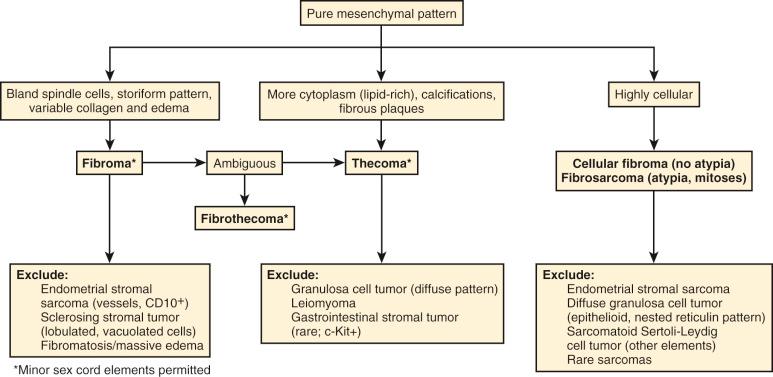


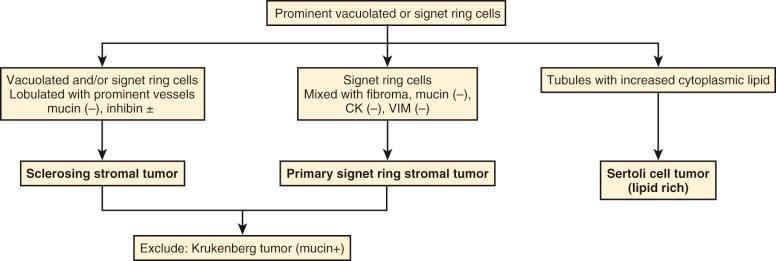
Fibromas are benign fibromatous tumors of varying cellularity with variable collagen deposition. Fibromas, including those showing partial thecomatous differentiation (so-called fibrothecomas), constitute the largest group of sex cord–stromal tumors, accounting for approximately 80% of this group.
Fibromas can occur at any age but are uncommon in women under age 30, predominating in the fifth decade, with a mean age of 48 years old. Most are incidental findings discovered at the time of surgery for other causes, but if they produce symptoms, the most common is abdominal pain. They may be associated with Meigs syndrome (ascites and pleural effusion), particularly when they are large (>10 cm), and nevoid basal cell syndrome (also known as Gorlin syndrome , an autosomal-dominant disorder characterized by developmental defects of the skeletal system and a predisposition to develop multiple basal cell carcinomas and ovarian fibromas) but are not linked to appreciable hormonal activity.
Fibromas are typically unilateral; nevertheless, they represent the most common sex cord–stromal tumor to involve both ovaries. Ovarian fibromas resected at Brigham and Women's Hospital over 1 year ranged in size from less than 1 to 16 cm, with an average size of 3.8 cm. More than 80% were greater than 5 cm, and 9% were bilateral. They typically have a smooth or slightly lobulated surface. They are characteristically solid with a firm, white to tan cut surface ( Fig. 27.7A ). Edema, cyst formation, and calcification are not uncommon; the latter is seen in up to 10% of tumors. Infarction and hemorrhage may be present but are uncommon. Of note, fibromas associated with Gorlin syndrome are more commonly bilateral (≈75%), have a multinodular growth pattern, and are more frequently associated with calcifications (see Fig. 27.7B ).
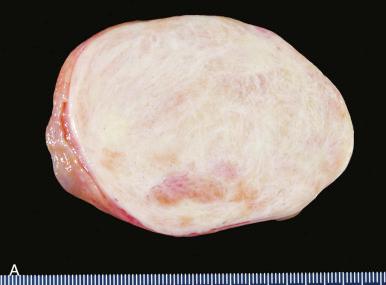
The bland spindle-shaped tumor cells, which are typically arranged in a swirling (storiform) pattern, are uniformly distributed with varying, but typically mild to moderate cellularity ( Fig. 27.8A ). The nuclei are small and elongated with tapered ends and have inconspicuous nucleoli. Cytologic atypia is absent, and mitotic figures are usually infrequent. Calcified plaques and bands of hyaline fibrosis are common (see Fig. 27.8B ).
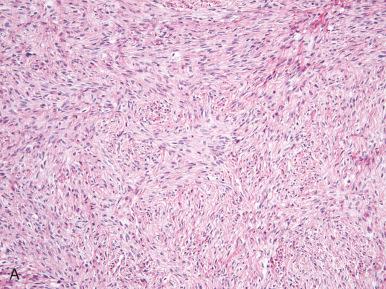
A rare finding is the presence of sex cord–like differentiation comprising less than 10% of the tumor, which typically appears as discrete tubules or epithelioid cords within the spindled stroma ( Fig. 27.9 ). Tumors with these features have been termed “fibroma with minor sex cord elements.” Although the presence of sex cord–like structures is a potential cause for confusion in the differential diagnosis with other sex cord–stromal tumors, particularly granulosa and Sertoli cell tumors, their presence in fibromas does not alter patient outcome. Other unusual features include bizarre nuclei, intracytoplasmic hyaline droplets, and Verocay-like areas.
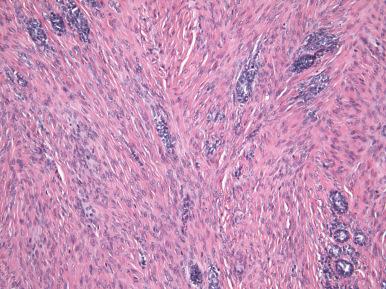
Fibromas are typically positive for SF1, FOXL2 (but lack the mutation), CD56, WT-1, ER, and PR but usually negative for CD10. They may be smooth muscle actin, calretinin, and inhibin positive although typically not diffusely; desmin and CD34 are usually negative.
Typical fibromas are easily recognized, although small ones may be confused with hypercellular ovarian cortex seen in polycystic ovarian disease or stromal hyperplasia/hyperthecosis. In some instances, it may be impossible to distinguish these latter entities from microscopic fibromas ( Fig. 27.10 ). The preservation of ovarian architecture and atretic follicles in the stroma of these entities will distinguish them from fibroma. However, a diagnosis of “microscopic cortical fibroma” is appropriate if the changes are discrete. Fibromas should also be distinguished from thecoma, although these two tumors may show significant morphologic overlap, which has led to use of the term fibrothecoma . Of note, this terminology is not recognized by the 2014 WHO; however, we still believe it is a practical term in some scenarios. In contrast to thecoma, fibromas typically lack a nodular growth pattern and cells with abundant pale to vacuolated cytoplasm. Moreover, they usually do not show the same degree of positivity for inhibin and are typically negative for CD10.
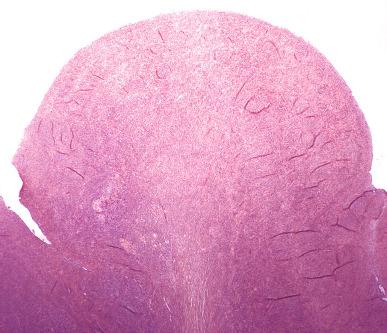
Conventional-appearing fibromas typically do not recur and are cured by simple excision.
Cellular fibromas and fibrosarcomas will be discussed together, inasmuch as the pathologist must distinguish the two whenever he or she encounters a “fibroma” with increased cellularity and mitotic activity. The term cellular fibroma is used to describe fibromas with increased cellularity similar to that seen in diffuse-type adult granulosa cell tumor. In comparison to the frequency of conventional fibroma, cellular fibroma and fibrosarcoma are much less common, with cellular fibroma accounting for approximately 10% of all ovarian fibromas.
Similar to conventional fibromas, cellular fibroma and fibrosarcoma predominate in the fifth decade, although fibrosarcoma tends to occur in older women; one fibrosarcoma in a child has been linked to the basal cell nevus syndrome.
Cellular fibroma and fibrosarcoma are typically unilateral tumors, and both are usually larger in size than conventional fibromas. Moreover, cellular fibromas may also have a softer consistency and a tan to yellow color rather than the firm, white appearance of a conventional fibroma ( Fig. 27.11A ). In addition, cellular fibromas tend to more commonly be associated with rupture and surface adhesions. Fibrosarcomas, which can be solid or partially cystic, are also usually softer and more commonly associated with hemorrhage and necrosis (see Fig. 27.11B ).
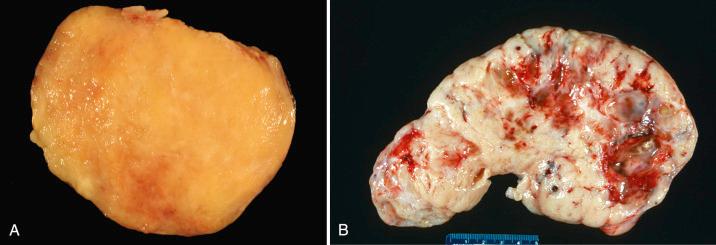
Cellular fibromas and fibrosarcomas are composed of a densely packed proliferation of spindle cells, with a storiform or herringbone growth pattern. The histologic diagnosis of either requires attention to the following.
In contrast to conventional fibroma, cellular fibromas show increased cellularity similar to that of the diffuse-type adult granulosa cell tumor ( Fig. 27.12A and B ). Often these tumors are not uniformly cellular and have areas typical of conventional fibroma, although they tend to lack the hyaline bands and edema that is frequently associated with the latter.
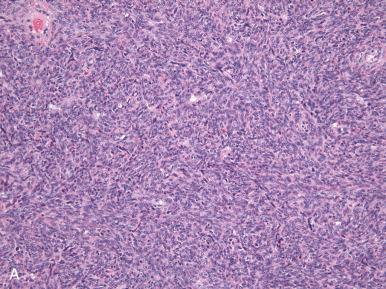
Relative to cellular fibromas, fibrosarcomas are very uncommon. Overall, they are a rare malignancy, representing less than 1% of all primary ovarian tumors. In an early study by Prat and Scully, fibrosarcomas were distinguished from cellular fibromas based on mitotic index. (Tumors with fewer than 3 mitoses per 10 high-power fields [HPFs] were considered fibromas.) The outcome for patients with sarcomas was dismal, with all six of them dying from their tumors. However, all cases in this series with recurrences or metastases (including cases classified as cellular fibromas) had either moderate or severe cytologic atypia (see Fig. 27.12C ). A more recent report of 75 cellular fibromas with a bland cytomorphologic appearance revealed that even those that were mitotically active (more than 4 mitoses per 10 HPFs; range 4 to 19 per 10 HPFs; mean mitotic rate of 6.7 per 10 HPFs) had an uneventful outcome (follow-up in 18 of 40 patients; mean follow-up of 4.75 years; range of 3 months to 12 years). Thus, it appears that mitotically active variants of cellular fibromas are relatively frequent, and the presence of mitotic activity alone in a cellular fibromatous neoplasm is not indicative of malignancy, although more cases with long-term follow-up are needed. Of note, however, cellular fibromas may occasionally locally recur, particularly those that are associated with surface adhesions or rupture; therefore, long-term follow-up is recommended for all patients with this tumor type. The diagnosis of fibrosarcoma should be limited to those tumors with moderate to severe cytologic atypia and high mitotic activity.
Become a Clinical Tree membership for Full access and enjoy Unlimited articles
If you are a member. Log in here